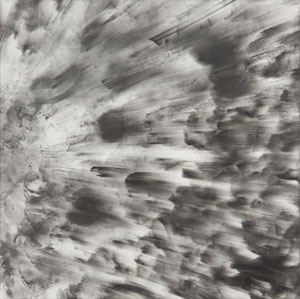4.18.25 — Experimental Music
If John Zorn leaves a single image, it is of himself, again and again, wielding a mean tenor sax. It suits a musician who dares to think for himself and on the fly.
He has fronted jazz bands and stretched the limits of rock. He has taken on the rigor and premeditation of a modern composer and arranger, too, from extended suites to bursts of counterpoint. You are as likely to hear him on a sound track as in the concert hall. Just try to pin him down. Just try, in fact, to call him a creative artist, but the Drawing Center shows him thinking in pictures, alongside Ericka Beckman through May 11. 
John Zorn does come with a label, experimental music, for a composer past seventy and still in the midst of things. Naturally his scores are often as not for experimental filmmakers like Jean-Luc Godard. And his work on paper looks very much like experiments, torn right from the lab, sometimes seen but not often heard. A recent series greets you on the way in with black spatters darkening into shallow pools and stretching into thin, irregular traces as if emerging before your eyes. They look as much like text results as like Jackson Pollock drips, and their technique suggests the laboratory as well. Whether in ink, charcoal, or pencil, it has a collective shimmer, as if lit from within.
If that suggests a certain insularity, he calls the show “Hermetic Cartography,” and do not pretend that you always get it. Hermetic means insular, much as many a hermit is found speaking to himself or to no one at all. At the same time, cartography is mapping, from another tendency in the avant-garde, toward arguing and explaining, and one sketch doctors a map of New England, like a key to the art world. Who can say why? It could be a stretch just to call Zorn a visual artist, and a Wikipedia article about him does not so much as mention it. The show itself relies just as much on ticket stubs and program notes as drawing, like something more insular still.
Still, the shimmer is often real. Not everything works altogether for its own sake, assuming art ever should. A black-curtained room is a dead end, as memorabilia often are. Still, the pools and swirls have the ghostly beauty of a photogram or a medical scan. Do not forget, too, that an actual “rayogram” still belongs first and foremost to Man Ray in Dada and fine art. Then, too, if Zorn’s are not actual direct impressions, experimental art still relies for its success on mind games. Zorn is always explaining.
He is also always in that space between improvisation and formal composition, popular culture and unconcern for a wider public. He is a born collector, unable to put much of anything to use or to throw it away. Often, too, things make explicit reference to popular art. The souvenirs have flatter outlines and color, like cartoons, and at least one refers to sound not by musical notation, but with a word like twang or splat. It also recalls just how much music in a composer’s hand is also an art—and how much notation, too, has its limits. Not everything here is all that beautiful, but then not everything has to be.
Exhibitions continue in the back room with Beckman and “Power of the Spin.” It would be a decent enough title for Zorn’s show, too, doing its best to put a new spin on things. One might well mistake her for more of him. She picks up on his Pop Art, in larger work that looks very much like comic books and collectibles. Downstairs she adds a projection based on a project by Zorn, like a step toward animation. Yet it is also a step toward live action.
It has just two characters, a man in overalls and a woman with green flesh. He is dressed the part for Jack and the beanstalk, while she is undressed for the part as Rapunzel. Choose your myth. More often, though, Beckman embeds her characters in a literal carnival, with art as its rides. An artist of the “Pictures generation” of the 1970s, she has a fondness for narrative and a promise of critique. If her characters are taking risks, the best of Zorn’s appear to explode.
Read more, now in a feature-length article on this site.
